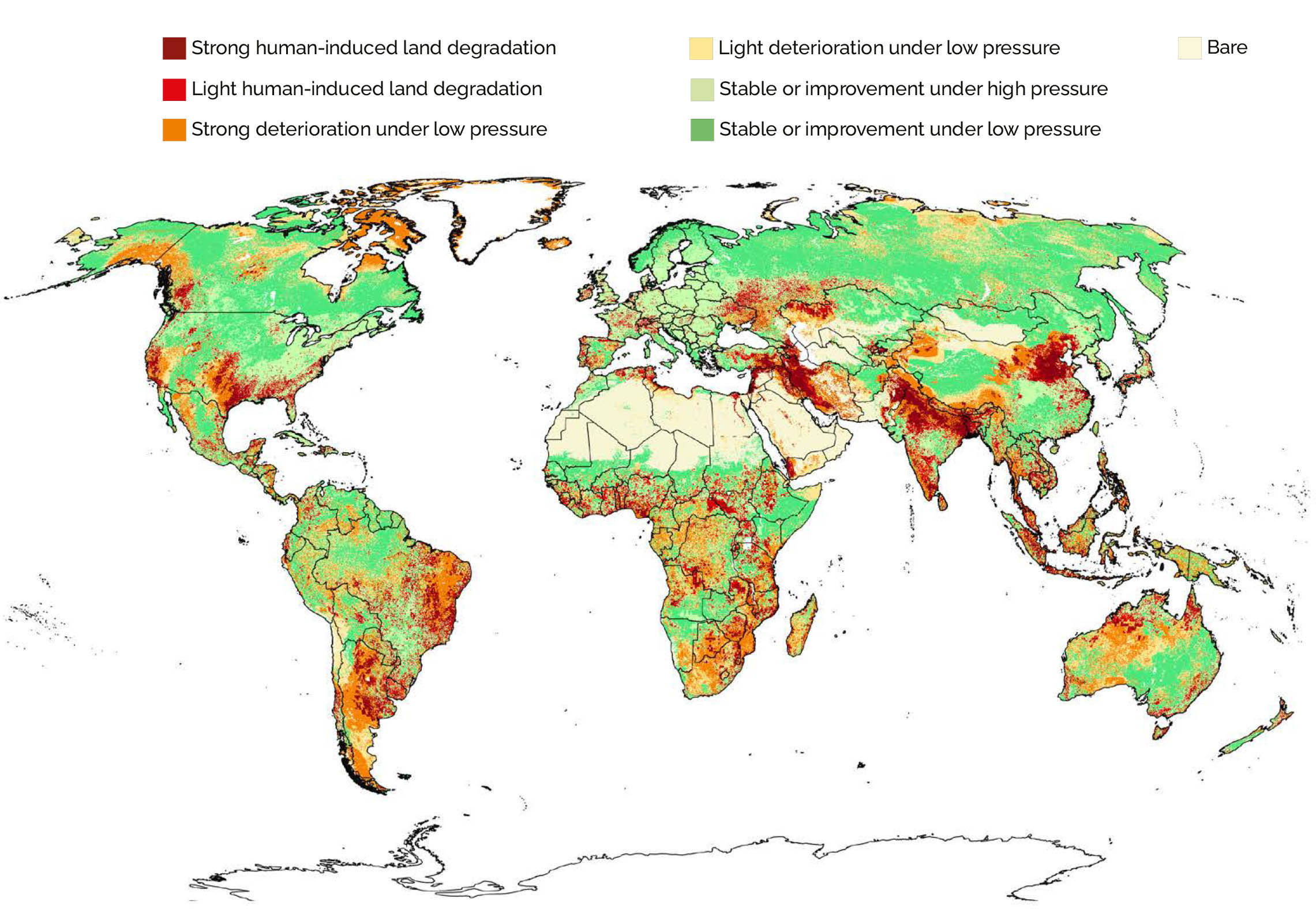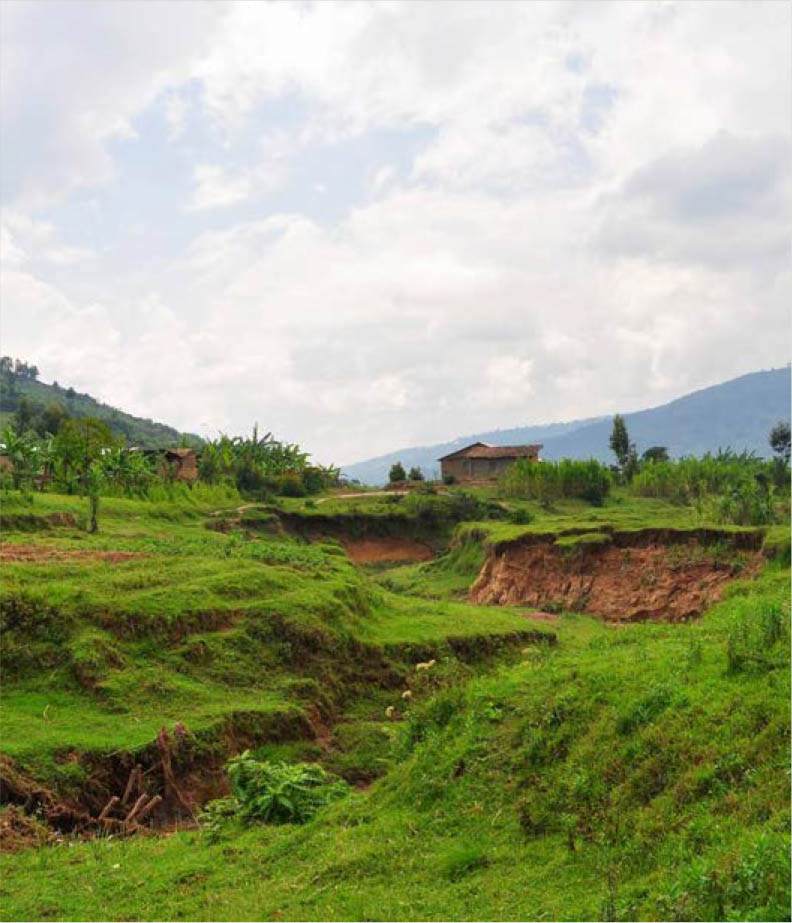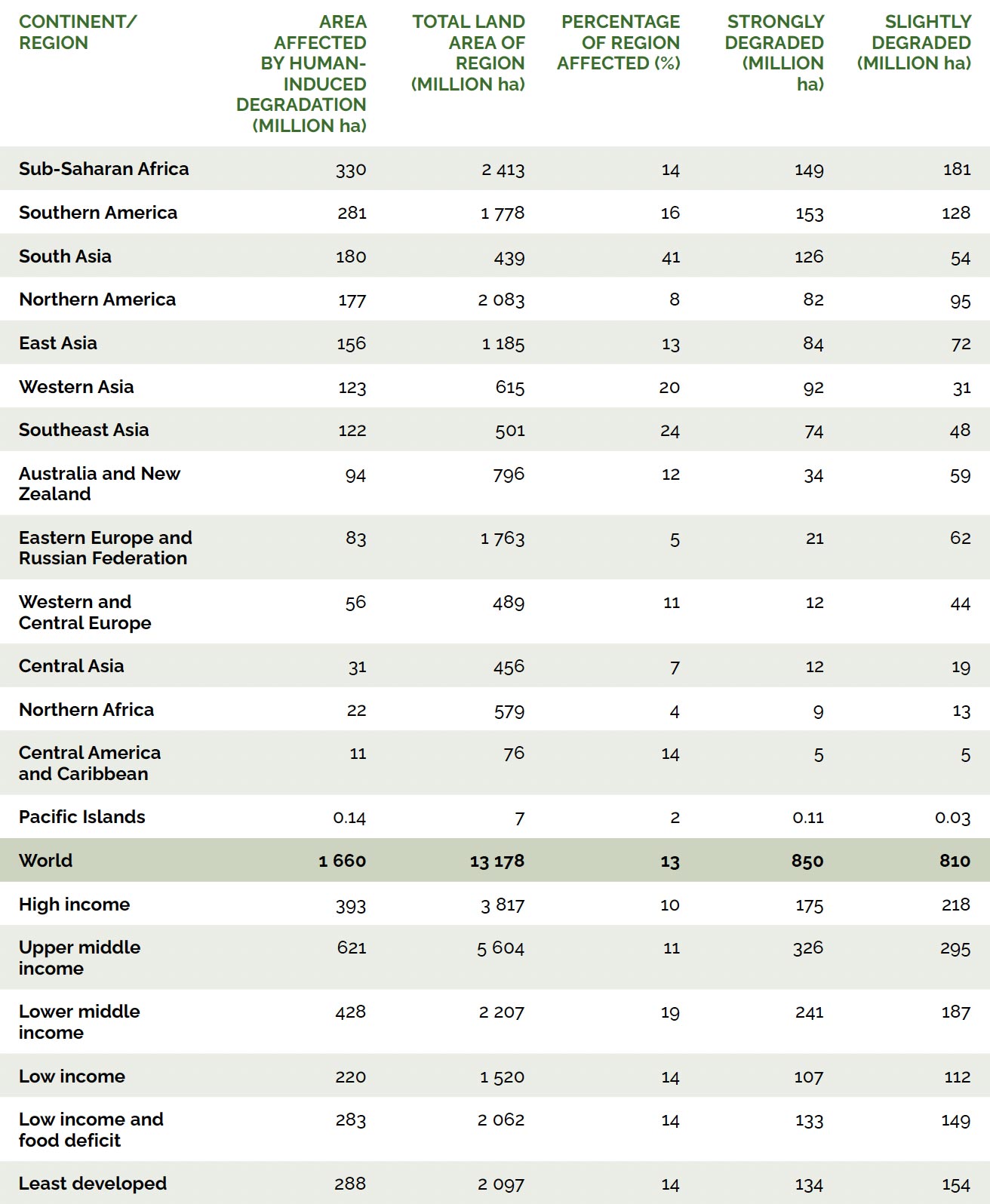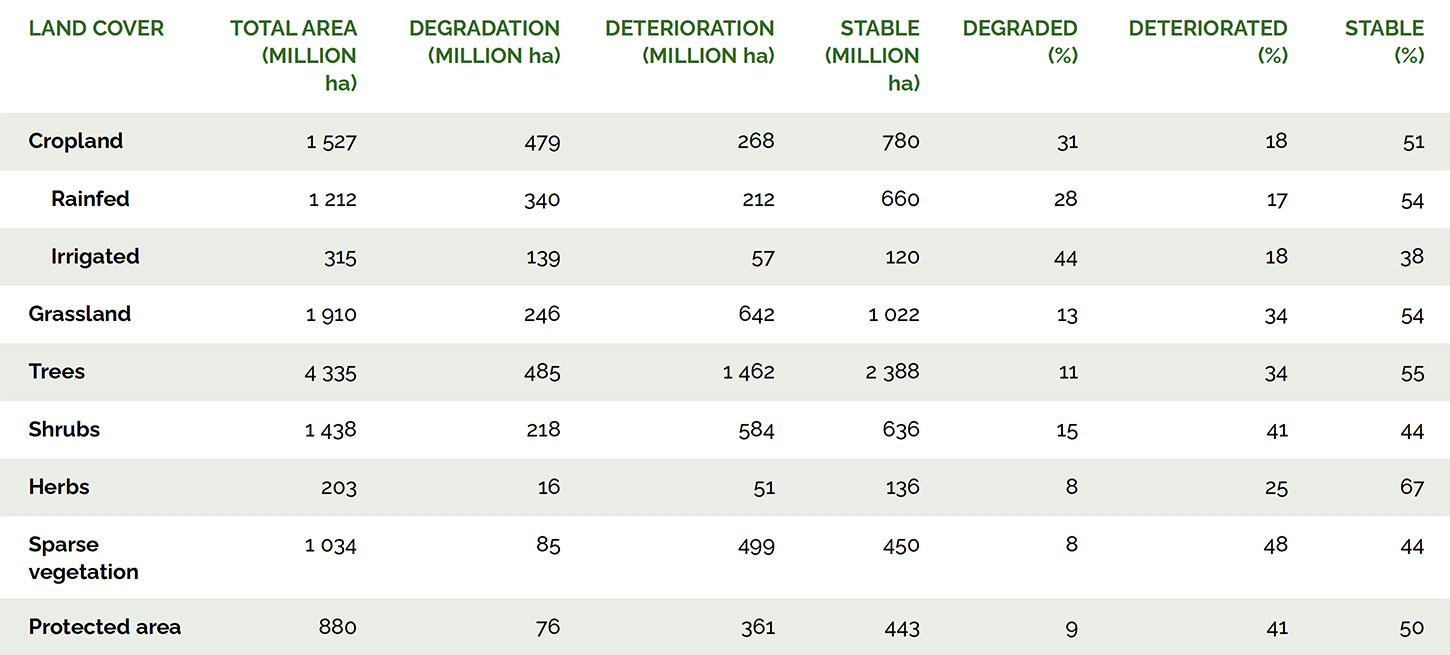1 State of land, soil and water
1.2 Human-induced land degradation
As agriculture intensifies, converging evidence indicates the extent and severity of land degradation (Map S.7), where soil is eroded, nutrients are depleted and salinity increases. Human-induced degradation affects 34 percent (1 660 million ha) of agricultural land (Table S.2). Extending cultivation into areas of marginal land quality and increasing intensification on existing cropland are constrained by soil erosion and depletion of carbon, nutrients and soil biodiversity. The treatment of soils with inorganic fertilizers to increase or sustain yields has had significant adverse effects on soil health, and has contributed to freshwater pollution induced by run-off and drainage.

Source: Coppus, forthcoming, modified to comply with UN, 2021.

Source: Coppus, forthcoming.
Box S.1 summarizes the method used to assess global land degradation based on adaptation of the Global Land Degradation Information System (GLADIS).
Box S.1 Global land-degradation assessment using an adapted GLADIS method
Overall biophysical status and trend indices are determined using an adapted GLADIS methodology. This applies a geographic information system approach to calculate separate biophysical status and trend indices for six components – biomass, soil health, water quantity, biodiversity, economic services and cultural services. It combines them to give an overall status index and a trend index. Trends refer strictly to changes over time.

Maps for overall biophysical status, trend and cumulative pressure represent three different dimensions of land degradation. When combined, they give insight into the relationships among the patterns, processes and their causes. Regions at risk occur when the overall status and trend are combined. Areas with a low biophysical status and exposure to deterioration are at risk of ending in a degraded state. Areas with high biophysical status and exposed to substantial deterioration are also likely to be at risk. Integrating pressure from human activities with biophysical status and trends is a first step in distinguishing natural from human-induced degradation.
Maps published in peer-reviewed journals provide input layers. The criteria for selecting these include availability, readiness to be used, relevance according to the literature and publication date.
The biophysical status of land resources is based on nine input layers that reflect their present (or latest known) biophysical condition. These include soil nutrient availability, SOC, water erosion rate, wind erosion, groundwater recharge, water stress, native species richness, above-ground biomass and artificial land cover (urban and infrastructure).
The trend is based on seven input layers that indicate changes in soil, water, vegetation and population density; they include changes in soil erosion, soil protection, fresh water, water stress, land productivity and forest biomass. The time factor varies between 10 and 20 years.
Direct anthropogenic drivers are used to estimate pressure exerted by human activities: agricultural expansion, deforestation, fire extent and frequency, grazing density, population density and ratio of invasive/native species.
Regions at risk are large contiguous areas with low biophysical status and subject to strong or light deterioration. Regions with substantial deterioration and interspersed high and low biophysical status are also at risk. Stable or improving areas are presently not at risk.
Land-degradation classes are defined based on the trend of land deterioration and the presence of anthropogenic drivers. A highly negative trend coinciding with high pressure is characteristic of substantial human-induced land degradation. The land’s resilience (ability to withstand anthropogenic pressures) also plays a role, for instance, when strong anthropogenic drivers do not coincide with negative trends.

Globally, the biophysical status of 5 670 million ha of land is declining, of which 1 660 million ha (29 percent) is attributed to human-induced land degradation. The remaining 4 010 million ha is classified as deteriorated caused by natural processes or has an anthropogenic origin. About half of the deteriorated land has a low status, and is likely to be more sensitive to degradation processes than high-status areas. About 656 million ha, 12 percent of the overall global decline, is under moderate pressure, which may be enough to trigger human-induced land degradation. Most of these areas are probably affected by human-induced land degradation, which means about 41 percent of the global decline can be attributed to human-induced land degradation.
Table S.3 shows the regional breakdown of the global estimate of human-induced land degradation. A fifth of human-induced degraded land is in sub-Saharan Africa, followed by Southern America with 17 percent. Northern America is about five times the size of South Asia, but both regions contributed 11 percent to global degradation. In relative terms, South Asia is the most-affected region, with 41 percent of its area suffering from human-induced degradation, of which 70 percent is strongly degraded. Southeast Asia follows with 24 percent, of which 60 percent is severe, and Western Asia has 20 percent, of which 75 percent is strongly affected. Deserts are not included in these estimates.

Source: Coppus, forthcoming.
Human-induced land degradation primarily affects cropland. Although cropland covers only 13 percent of the global land-cover classes (11 477 million ha), degraded cropland accounts for 29 percent of all degraded areas. Almost a third of rainfed cropland and nearly a half of irrigated land are subject to human-induced land degradation (Table S.4). Grassland and shrub-covered areas that are used to graze animals or as sources of fodder have declined by 191 million ha over two decades to 3 196 million ha in 2019, and converted to cropland. Some 13 percent of the grassland area is degraded due to high anthropogenic pressures, and 34 percent has reduced biophysical status due to overgrazing and inadequate livestock mobility causing soil compaction and erosion, thus affecting soil function, plant growth and hydrological services. Intensive livestock production, which has grown rapidly to meet expanding demand for meat, particularly in middle- to high-income countries, places pressure on in situ water and soil resources for intensive feed and forage production. Concentrating inputs and animal waste have resulted in higher energy use from fossil fuels, higher methane emissions and higher point source water pollution from nutrients and antibiotics.

Source: Coppus, forthcoming.
Over 60 percent of irrigated areas are degraded in Northern Africa, South Asia and the Middle East–Western Asia. The largest degraded areas are in the northern hemisphere, except for Southeast Asia. Globally, only 38 percent of irrigated land is stable.
In the Middle East and Western Asia, agricultural expansion, grazing and accessibility drive degradation, while in the densely populated areas of East Asia and South Asia, good accessibility and high grazing density are exerting high pressures on irrigated fields. Grazing, accessibility and deforestation drive environmental change in irrigated cropland in Southeast Asia. Grazing, accessibility and agricultural expansion contribute most to the pressure for irrigation expansion in the eastern United States of America.
The declines in status in East Asia and the Middle East–Western Asia are mainly due to decreasing freshwater availability, increasing water stress, reducing soil protection and increasing population. Similar degradation processes occur in South Asia. Major degradation processes in Southeast Asia are increasing erosion rates, rapidly decreasing forest biomass and increasing population. In the eastern United States of America, the primary degradation processes are decline in available fresh water and loss of soil protection. Problems are similar in the western United States of America, but rising population density brings additional pressure.

